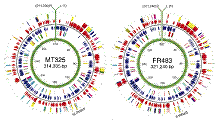Virology, Nebraska Center for
Document Type
Article
Date of this Version
6-1-2004
Abstract
Background. The seroprevalence of Kaposi sarcoma–associated herpesvirus (KSHV)/human herpesvirus 8 (HHV-8) in sub-Saharan Africa suggests that multiple routes of transmission exist. In the present study,we examined 2 possible routes of mother-to-child transmission, through breast milk and saliva, during the first 6 months after delivery. Methods. The prevalence of HHV-8 DNA in the breast-milk cells (n=75), milk supernatant (n=56), colostrum (n=2), and saliva cells (n=65) of HHV-8–seropositive mothers who recently gave birth was examined. Polymerase chain reaction analysis was performed for the detection of HHV-8 in cross-sectional samples isolated at 2, 4, and 6 months after delivery.
Results. None of the 75 breast-milk samples but 2 of the colostrum samples that were analyzed contained HHV-8 DNA at a limit of detection of ∼1 HHV-8 copy/104 cellular genomes, whereas Epstein-Barr virus DNA and HIV-1 DNA were detected in 16 and 22 samples, respectively. Analysis of 65 saliva cell samples, which were obtained from mothers who also provided milk samples, revealed that 19 of the samples had detectable HHV-8 DNA. Viral DNA was found at all time points, but the presence of viral DNA in saliva was independent of maternal HIV-1 serostatus ( x2=0.33; P=.57).
Conclusions. Our findings demonstrate the lack of HHV-8 DNA in the breast milk of seropositive mothers, and they suggest that contact with breast milk is not a likely source of horizontal transmission of virus to infants in sub-Saharan Africa.



Comments
Published by The Journal of Infectious Diseases 2004; 189:2260–70. Copyright © 2004 by the Infectious Diseases Society of America. Used by permission.